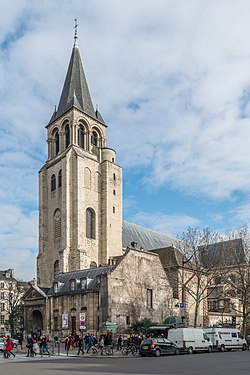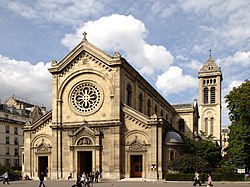| Name | Image | Address | Type | Summary |
|---|
| Sainte-Chapelle |  | Ile de la Cité (1st arrondissement of Paris) | High Gothic and Flamboyant (1238–1248) | The royal chapel built by Louis IX to contain his collection of Passion relics, including Christ's Crown of Thorns – one of the most important relics in medieval Christendom. It is noted especially for its towering walls of stained glass. [1] |
| Saint-Eustache |  | 1 Rue de Jour (1st arrondissement of Paris) | Flamboyant Gothic Parish church (1532–1640) | Located next to Les Halles markets, rebuilt on a vast scale between 1532 and 1640 in the Flamboyant Gothic style, with touches of the Italian Renaissance. [2] |
| Saint-Germain l'Auxerrois |  | Place du Louvre (1st arrondissement of Paris) | Rayonnant and Flamboyant Gothic Parish church (13th–15th century | Located next to the Louvre, this was the parish church of the Kings of France and their court. First constructed by Robert II the Pious in the 12th century, it was rebuilt on a larger scale in the 13th century, then enlarged again in the 15th and 17th centuries. Along with the Sainte-Chapelle, it the only Paris church that has its original Gothic porch. [3] |
| Saint-Leu-Saint-Gilles |  | 92 Rue Saint-Denis, 1st arrondissement of Paris | Early Gothic (1235), Renaissance (1611) 18th century (Crypt) | Since 1780 the church is the headquarters of the Knights of the Holy Sepulchre. Artwork includes alabaster sculptures from Nottingham (15th century) a statue by Jean Bullant (16th century), and colourful 19th century stained glass. |
| Saint-Roch, Paris |  | Rue St. Honoré, (1st arrondissement of Paris) | Baroque and Classical style parish church (1653–1740) | The church was begun by Louis XIV in 1653, but was not finished until 1740. The architecture was directly inspired by the new style of the Church of the Gesù in Rome. The interior offers a succession of three lavish chapels in succession after the choir, highly decorated with paintings and sculpture. In 1795 Napoleon Bonaparte ordered his soldiers to fire on counter-revolutionary soldiers gathered on the church steps, launching his military and political career. |
| Notre-Dame-de-l'Assomption |  | 263 rue Saint-Honoré (1st arrondissement of Paris) | French Baroque, Classicism (1670–1676) | The church was constructed to the plans of Charles Errard for the convent of the Dames-de-l-Assomption, or the Nouvelles Haudriettes, founded in 1264. The rest of the convent was destroyed in the French Revolution, while the church became a depot for opera and theatre decoration. It was returned to the church by Napoleon in 1802, and in 1850, it was given to the Polish Catholic Mission in Paris. The dome is modelled after the Pantheon in Rome, and the porch after that of the Sorbonne in Paris. It contains work by French painters of the 18th century, including Carle Vanloo. The painting on the interior of the dome, "The Assumption of the Virgin", is by Charles de La Fosse, who also painted the interior of the dome of Les Invalides [4] in Paris. |
|































































